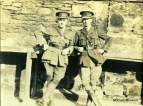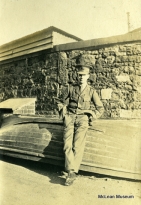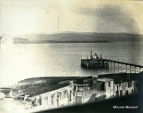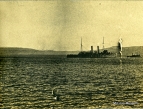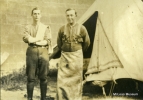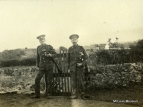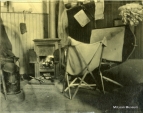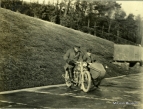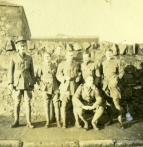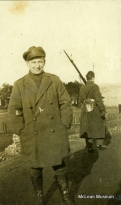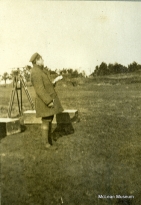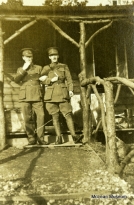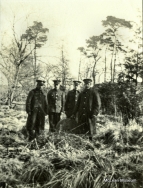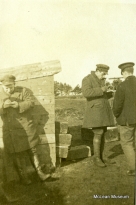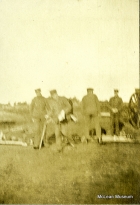Lithgow’s Boys
The Clyde Royal Garrison Artillery was a territorial unit with their HQ in King Street, Port Glasgow. At the outbreak of war in 1914 there were three Garrison Companies, No.1 (Port Glasgow), No2 (Helensburgh and Dunbarton), and No.3 (Dumbarton) Coy withunits at Fort Matilda, & Cloch. In autumn 1914 the Fort Matilda was manned by 2/1 Company, Clyde Royal Garrison Artillery - led by James Lithgow, of shipbuilding fame. The Birkmyres, of Gourock Ropework fame were also involved, related through marriage to the Lithgows.
The men of the Clyde RGA were fit and powerfully built, a necessity because of the need to handle the heavy ordnance that was associated with static defences. Early in the war many members of the garrisons, volunteered for Foreign Service, and by 1915, replacements had been recruited and trained. Significant numbers of these replacements also volunteered for service abroad. Because of these pressures, recruitment to the Clyde RGA was extended by April 1916 to include men in the age range 41-47 who were considered unfit for general or overseas service. By August, with conscription now in force, the War Office was stressing the urgent necessity of finding suitable candidates for commissions in the Clyde RGA, and among those whose names were put forward were gunners, privates, and cadets. In addition to recruitment problems, both Portkil and Fort Matilda were now feeling the effects of another factor in the equation. With the installation of an anti-submarine boom across the estuary in 1915/16, stretching from Dunoon to Cloch Point, the emphasis on static marine defences now switched further down river.
Portkil lost two of its most powerful guns to the new battery at Cloch Point in October 1916, and Fort Matilda likewise had two guns re-deployed elsewhere in February 1917. The idea that it might all be over by Xmas soon dispersed and it became obvious that siege warfare, and the need for heavy artillery was an increasingly important part of the war in France and Belgium. The Garrison boys were in demand. As the months passed, groups of men were sent south to a variety of Siege Batteries for training and deployment. It is therefore quite difficult to trace these men and their war careers as they didn’t all serve together as one unit.
A section of territorial Royal Engineers or Fortress Company was also based at Fort Matilda, whose job was to look after the electric lights which were used to illuminate the Clyde at times of emergency. Lithgow and many of his men were first away. They joined the 40th Siege Battery, and went out to the Western Front on 28 Feb 1916 armed with four 6-inch howitzers and joined 34th Heavy Artillery Brigade on 6 Mar 1916. Lithgow wrote ‘Rather more than half of the T.F. are with me and we have joined up with half of another battery. I am in charge. We had a hell of a time getting here; all night travelling—day reconnoitring—all night getting our “stuff “into position up a road like from Ormsary House to half way from the bridge to the fank—lorries could not touch it so we had horses and men; we were ready with all guns by daylight and kept firing away all day, also the next and through the following night. We have now had a peaceful day and night, and up to now it is quiet, but we rather expect Fritz to hit back. We got nothing much near us and really the show was quite magnificent, the whole valley in the dark being often so lighted by flashes as to let you see your way perfectly. We have still a lot to do digging holes for ourselves and clearing out old chalk pits in the face of the hill for protection. I have now got a tin shanty close into the hill and hope to have a real earth by tomorrow which will be quite safe. There is not a house for miles. In good weather it is quite alright.’
He was deeply concerned for his men. His deerstalker’s skill in making use of cover had helped him to train them in a way that prevented many casualties. He used a shipyard technique to cover his guns with camouflage which could be hauled away by ropes as soon as ‘Action’ sounded and replaced as quickly by a counter-haul. But he could not conceal his tears when the first gunners of his battery fell. The comradeship of those he had known in Port Glasgow or its neighbourhood meant a great deal to him. A wounded signaller, whose deeds earned him the D.C.M., could not be traced for a while after he was sent back for treatment, and his commander spent anxious hours searching for him on the lines of communication when the battle slackened. When an invalided officer returned he showed his pleasure in a letter to his brother: ‘He is so cheery and so unEnglish, which is a relief.’ A staff sergeant who afterwards made his career in the Lithgow yards give us a picture of the man: ‘There were just our lads there, and one fellow with a clarionet, and all of us singing, and Major Lithgow sitting cross-legged over a barrel of beer conducting the proceedings with a pig’s trotter. We were all calling for our favourite tunes, and then somebody shouted: “Come on, sir, what’s your favourite?” The Major hesitated, and while he was making up his mind a lad at the back imitated his voice and shouted: “Get on with the work” (James Trann, interviewed in the Lithgow Journal, autumn 1953.)
George Mallory, the famous climber, served with the 40th from May 1916 for a year – his best friends were Robert Graves and Rupert Brooke. Mallory was assigned to the Battery, then in position in the northern sector on the Western Front. That summer he took part in the Somme offensive. He wrote to his wife about the bombardment that took place before the infantry attack: “It was very noisy. Field batteries again firing over our heads (of course there are plenty in front of us too) and most annoying of them a 60-pounder which has a nasty trick of blowing out the lamp with its vigorous blast.”
Later that month George Mallory saw flamethrowers in action for the first time. He described how he saw “a sort of liquid fire, a long line of trenches apparently on fire and exploding with great flashes and clouds of sparks.” On 15th August 1916 he wrote about the large number of people killed during the Somme Offensive; “I don’t object to corpses so long as they are fresh... With the wounded it is different. It always distresses me to see them.” Mallory was constantly worried about the dangers of killing his own men. He wrote in a letter to his wife about this fear: “Before I went to sleep I heard distinctly from the murmur of voices in the tent some mention of our troops being shelled out of a trench by our own guns... I can’t tell you what a miserable time I had after that. You see, if my registration had been untrue, it was my fault... I went over and over again in my mind all the circumstantial evidence that it was really our shells I had seen bursting and had horrid doubts and fears.”
“The surroundings are indescribably desolate and dotted with small crosses. We haven’t many dead in the trenches (at least only one decapitated unfortunate has been discovered below the surface) but those outside could well do with some loose earth over them.”
The slideshow below shows photographs of the men of the Clyde RGA and others while stationed at Fort Matilda taking part in a variety of pursuits - route marches, manning guns at Lyle Hill, firing guns at Ardhallow and so on
Service men and women of Clyde Royal Garrison Artillery
- Frank Russell Burnet
- James Lithgow
- Murray Stewart
- Walter Burnside
- Henry Malcolm
- Robert Buntain
- James Cockburn
- W McBain
- John Mcmillan(RGA)
- Alexander Craig
- Alex McGhee
- William Craig
- James Moore(RGA)
- John Finlay
- George Morrow
- David Ayton
- John Cameron Forrest
- Thomas Shields
- John Birkmyre
- William Crockatt Thorne
- William Tough




